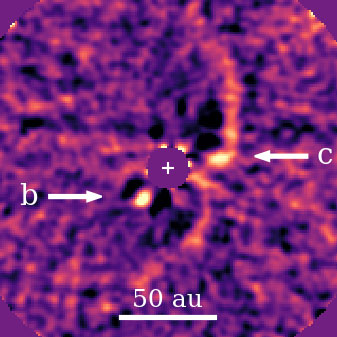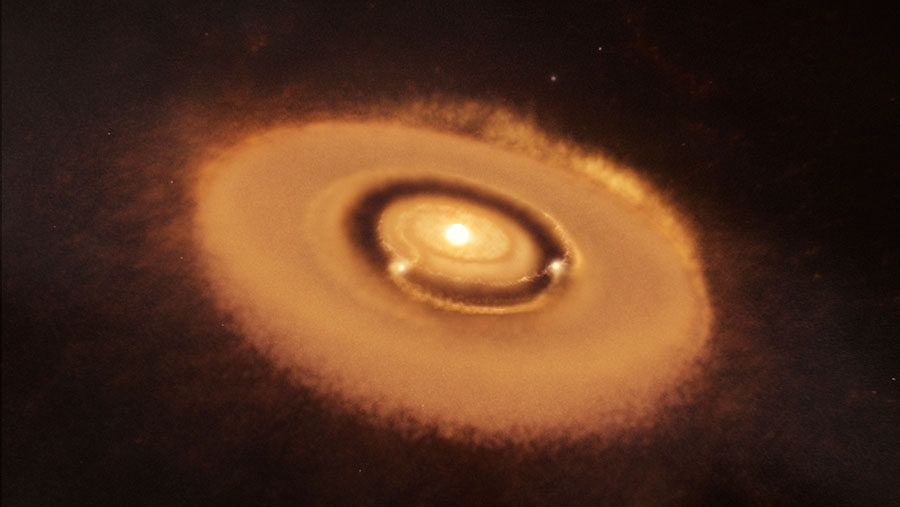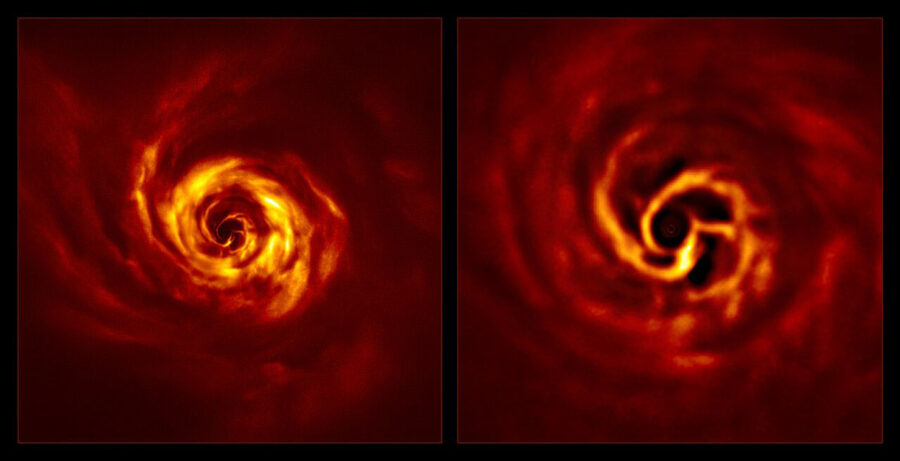Two new sets of observations show astronomers what planet formation looks like.
New Images of Newborn Planets
New observations of PDS 70, a star 370 light-years away in the constellation Centaurus, have confirmed the existence of two newborn giant planets in the system. Astronomers had discovered PDS 70b previously, but data on PDS 70c were more tenuous. (Read about the discovery of PDS 70b and PDS 70c.)

J. Wang (Caltech)
The new observations, taken with the Keck II Telescope atop Mauna Kea, Hawai‘i, and published in the Astronomical Journal, didn’t lock down the planets’ orbits, as some had hoped. But they did shed light, literally, on the planets’ properties.
Both planets are a couple times the mass of Jupiter, though b is slightly more massive (between 2 and 4 Jupiters’ worth) than c (between 1 and 3 Jupiters). Observations of b also suggest it’s between twice and three times Jupiter’s size. Combined with previous observations, the data suggest the orbits of b and c are on average 20 and 34 astronomical units (a.u.) from the star, respectively.
The star is only 5 million years old, but while its planets are still accumulating mass, they’re doing so at a very slow rate — they’re likely already nearly grown. The planets’ emissions don’t contain any telltale features from chemicals in their atmospheres, though, and Jason Wang (Caltech) and colleagues suggest the planets may still be enshrouded in dust.

W. M. Keck Observatory / Adam Makarenko
Read more about the observations in the University of Hawaii’s press release.
Discovery: Planet Forming Around AB Aurigae
Meanwhile, astronomers have used the European Southern Observatory’s Very Large Telescope to go back even further in time, witnessing the turbulent swirls of planet formation around AB Aurigae, an even younger star 530 light-years away in Auriga.

ESO / Boccaletti et al.
At only several million years old, the AB Aurigae system is still in the throes of planetbirth. Previous observations with the Atacama Large Millimeter/submillimeter Array (ALMA) in Chile had shown spirals of gas within a vast, 120-a.u. gap in the disk of dust and gas surrounding the central star. The gap, and the gaseous spirals within it, had hinted at fast-growing newborn planets but didn’t provide definitive evidence of their existence.
Now, Anthony Boccaletti (University of Paris Diderot) and colleagues have taken closer-in and more sensitive observations using the Spectro-Polarimetric High-contrast Exoplanet Research instrument (SPHERE), showing the suspected planet formation in action.
SPHERE uses a coronagraph and polarization techniques to negate the light coming from the bright central star, revealing fine detail in the dust-and-gas disk around it. SPHERE’s image reveals that the spiral arms previously seen by ALMA continue inward into this gap toward the star. Nestled within one of these arms is a smear of light — a planet likely several times Jupiter’s mass that’s coming together within the S-shape swirl.
The researchers can’t be completely certain it’s a planet, though. The actual mass depends on how fast the object is growing, and if it’s currently growing slowly, then the object forming there could be a low-mass star rather than a planet.
Whatever the forming object is, it’s at 30 a.u. from its star, putting it on about the same orbit as Neptune’s around the Sun if its orbit is circular. Indeed, comparison with the ALMA images from four years ago show that the smear appeared there, too — and it has since then rotated around its star in a way that’s consistent with it being in orbit.
"The twist is expected from some theoretical models of planet formation,” says coauthor Anne Dutrey (Astrophysics Laboratory of Bordeaux, France). “It corresponds to the connection of two spirals — one winding inwards of the planet’s orbit, the other expanding outwards — which join at the planet location.”
The researchers say that, because the gap in the disk around AB Aurigae is so vast, there are likely more planets, as yet unseen, forming within the cavity.
Read more about the discovery in the European Southern Observatory’s press release.
 1
1









Comments
Lindsay
May 23, 2020 at 12:28 pm
The image looks similar to the arms of a spiral galaxy, on a much smaller scale, of course.
You must be logged in to post a comment.
You must be logged in to post a comment.